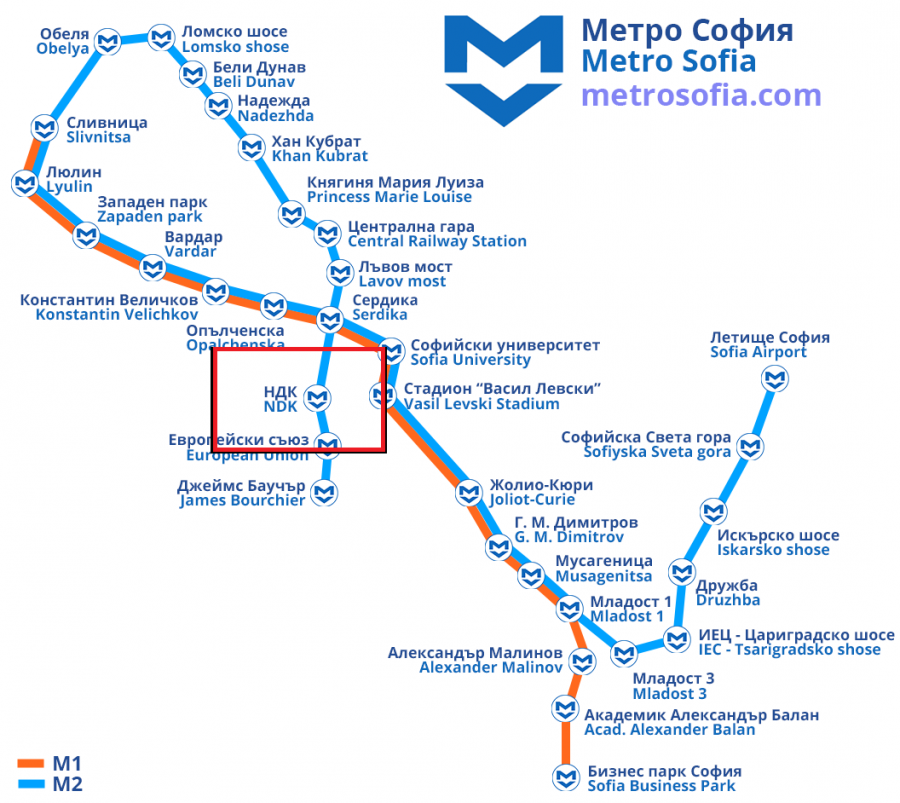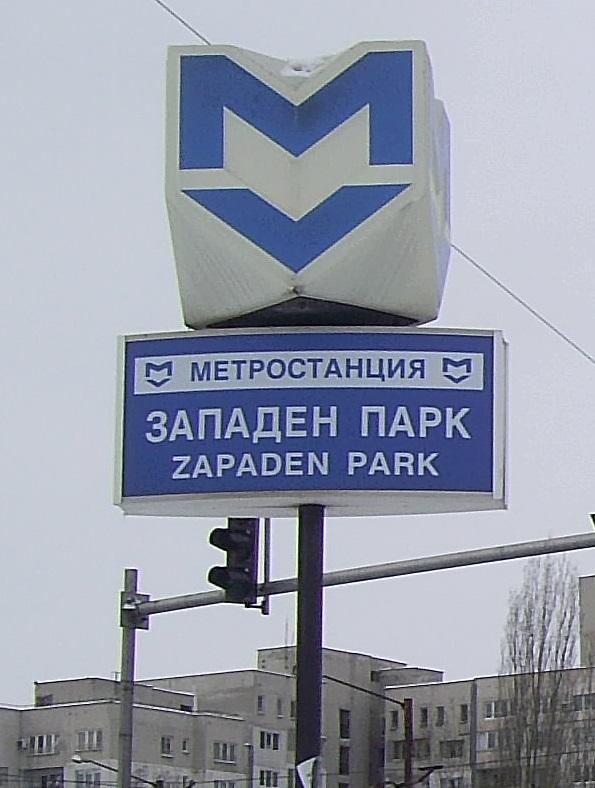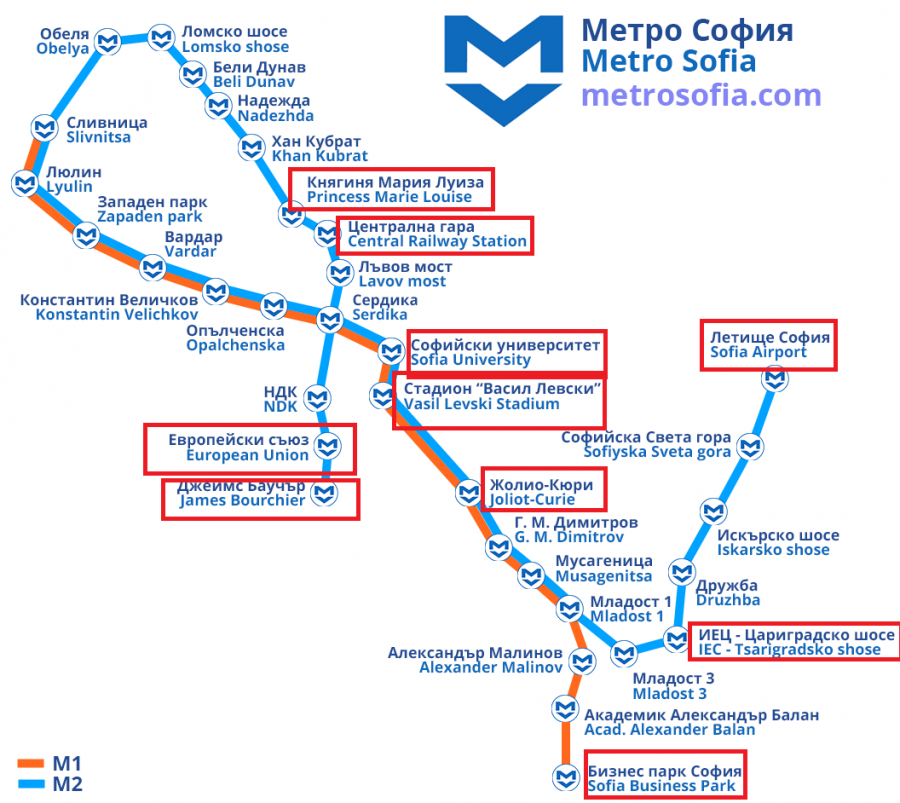
Exploring the Linguistic Landscape in the Sofia Subway
Public signs and language policy
Since becoming a member of the European Union in 2007, Bulgaria aims to modernize its public facilities, this includes making its public signs understandable for tourists and citizens who don't speak Bulgarian. In this paper, I will investigate how this aim was put into practice by analyzing the changing linguistic landscape of the Sofia subway and what part language policy plays in this endeavor.
Making the Sofia subway multilingual
An example of the modernization of Bulgaria is the the ongoing extension of the subway in the country's capital, Sofia. From 2015 onwards, English voice recordings are supposed to give travelers information about what the next and current stations are. Citizens, however, noticed that these recordings have a strong Bulgarian accent. The translation of the names of the stations is also often a problem in the Sofia subway. Some names are written correctly in English, but others are just Bulgarian names written in the Latin alphabet (e.g. Nacionalien Dvorets na Kulturata which means National Palace of Culture), which does not necessarily make them understandable for foreigners.
In this paper, I will discuss changes in the linguistic landscape of Sofia's subway, with the aim to discover who decides about these changes and what language policy perspective is implemented here. This includes the English translation of the texts and names on the signs and the way in which they are written. It also includes the characteristics and production of the voice recordings.
The linguistic landscape that will be analyzed in this paper consists of Line 1 and Line 2 of the Sofia subway. The data includes several photos, taken in this particular area, and some English voice recordings that are put in place to inform the subway's non-Bulgarian speaking (foreign) visitors. Online sources, such as the website of Sofia Metropolitan, the website of bTV, one of the official news channels in Bulgaria, and online platforms where citizens discuss common mistakes made in translations from Bulgarian to English, were used to collect data. The data collection took place in May 2016. Most of the pictures that will be analyzed in this paper could be found on such platforms. Of crucial importance for my analysis is an interview with a native English woman about her language experiences in the Sofia subway. I have used this interview for analysing the voice recordings. Data with regards to the linguistic landscape were easy to find, but one needs to delve deeper in order to understand the role of language policy in the modernization of the Sofia subway.
Signs are all around us. All of them have different aims – to convince us, to entertain us, to inform us or to provide us with a certain service. These signs, containing texts and/or images can be professionally made or not. The language that is used can be an indication of the monolingual or multilingual configuration of a specific area, of the producers of a sign, and of the intended audiences. For a sociolinguistic analysis of signs, for example when trying to unravel not only a sign's meaning, but also its underlying purpose, it is important to strictly define the borders of the area in which signs are analyzed, whether that's a specific urban or rural area, a university campus or an industrial zone.
The analysis will be conducted from three perspectives: past, present and future. With regards to the past, I will explore the conditions for the production of the sign, with special attention for the producer and the meaning of the signs. In doing so, I will perform a historical sociolinguistic analysis and go back to the time when Bulgaria was not part of any European and international institution. In those days, language policy regarding the use of English did not have a significant position. That could allow us to make changes that occurred years ago visible.
Attenetion
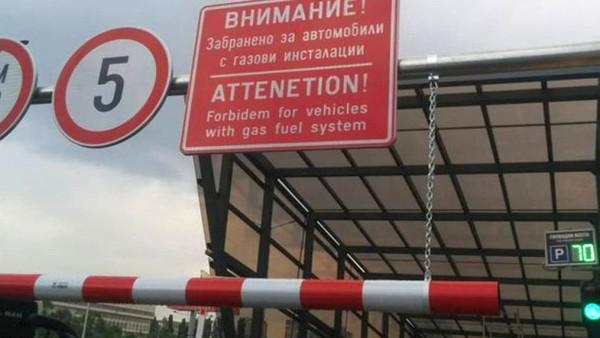
Figure 1: Information sign at Business Park subway station
The picture in Figure 1 was taken in the entrance of the car park at the Business Park subway station in Sofia. What we see is a sign that limits the maximum speed drivers are allowed to go (referring to a maximum speed of 5 km/hr) and another, larger sign, which is supposed to attract attention with its red color. On it are capital letters, saying ATTENETION, and it ends with an exclamation mark. This causes people to wonder about the meaning behind this sign. The Bulgarian text is spelled correctly, but the one in English does not seem to be written correctly in three aspects:
- First of all, the word “attention” in English has only one 'e', but here we see “attenetion” with a double 'e'.
- Secondly, the right way to write “forbidden” is with double 'd' and with an 'n' as a last letter, instead of “forbidem” with one 'd' and an 'm' at the end.
- Furthermore, the grammatically correct term would be bi-fuel vehicles instead of "gas fuel system". Online research of gas fuel system shows that this word order is not the appropriate way for saying it in English.
The picture of this sign was made by a citizen, who then posted it on Twitter. It became popular after bTV posted it on its web page and wrote a short article, with a humorous title, on it. The joking article, refers to two Bulgarian gentlemen's literacy in English – Hristo Stoichkov, a football player, and Nikolay Barekov, an EU MEP. Both are famous for their comic interviews given in English. Indeed, Sofia Business Park is one of the places where most international employees work and where international offices are located, so an accurate translation in English should be expected there.
On the signboard two languages are mixed. The English text aims to show tourists and foreigners that the subway and all its facilities are modernized and serve different needs. Sofia authorities try to show an adaptation to the EU, and in some way even a transformation to be a part of the European Union. In one way or another, the idea of 'westernization' can be observed in most of the public facilities. This sign is supposed to serve society. In terms of hierarchy, it can be seen that Bulgarian is on top as it is the official language of the country. However, the station and buildings around it constitute a bilingual, if not a multilingual, area and because of that a common language is needed. That is a decision of the authorities and it requires a careful attitude regarding language policy, in this case how to deal with the use of English on public signs. Moreover, Sofia Metropolitan, the firm which constructed the subway, should take care of the spelling of the foreign languages. The spelling mistakes and mistakes with grammar on the sign shows that the authorities don't seem to worry about language policy.
Audio recordings from the Sofia subway
The renovation of the Sofia subway took place between 2014 and 2015. Newly opened stations, such as Sofia Airport and Business Park Sofia, require a more internationally oriented language policy. In order to provide information to the travelers, English voice recordings were installed in the subway, as well as signboards near almost all of the stations. In this section I will have a look at three audio recordings made in 2015 and 2016 from Serdika station, Zapaden Park station and Konstantin Velichkov station.
Voice recording at Serdika station
Voice recording at Zapaden Park/ West park station
Voice recording at Konstantin Velichkov station
Almost immediately after these voice recordings had been installed, citizens started to comment on the key features of subway English pronunciation and word order on different social media platforms and forums. Some people found them quite ridiculous, because of the strong Bulgarian accent. Some shared their critique with the mayor of Sofia, Yordanka Fandakova. A Twitter user shared that as a teacher of Russian, Fandakova is supposed to know what language policy should be used when something as important as a subway is constructed. Sofia Metropolitan, the firm that built the subway, is owned by the Sofia Municipality. Therefore, it is the state’s responsibility to assure the accuracy of the information given.
For further analysis it is crucial to have a look at the point of view of non-Bulgarian speakers who use the Sofia subway. One of Bulgaria's main channels, bTV, made a reportage about the case, interviewing a native English woman who lives in Bulgaria, as well as tourists using the subway. Angela Robbers, the interviewed woman, shares that Cyrillic letters are exotic for many and that information boards in public transport should be readable for everyone. The first time Angela Robbers heard the station announcement in her mother tongue, she did not even pay attention, because of the bad pronunciation, wrong word order and some words that did not fit in the sentence correctly. In the reportage, the subway voice said “This is station Serdika”, which is typical for Bulgarian word order, but Robbers marked that it is common in English for the name to go before the subject. Ergo, the correct way of saying this in English would have been: “Serdika station”.
The voice recordings that were installed in the Sofia subway almost immediately attracted the attention of all travelers – both in positive and negative ways. The main object of the comments was the pronunciation of the lady who announced the stations and the word order, which is not correct in English. Usually, voice recordings for all railway transport facilities, including trains, are made in the city of Varna where a regional dialect is spoken. That not only affects the pronunciation of Bulgarian, but also the pronunciation of any other language. Citizens state that the strong Bulgarian accent in the English voice recordings could be really confusing for foreigners.
Furthermore, the word order in the announcement: “This is station Serdika” is a literal translation from Bulgarian. A correct station announcement would be: “Serdika station”. The Sofia underground has two lines (Line 3 is still under construction) and in order to switch from one to another, travelers have to switch the train in one of the central stations – Serdika. This rather important information is provided with the following announcement in English: “Change here for line two (or line one, respectively)”. As Angela noted, a more proper way to say this would be “Transfer here for line one”. In order to see what society thinks about these changes, an interview with a tourist who used the subway was taken into consideration, as well as comments by inhabitants of Sofia. The tourist shared his critique regarding the English pronunciation. On the other hand, he felt more comfortable when hearing a familiar language, regardless of the accent. Moreover, inhabitants have different opinions – some said that this innovation is good for Bulgarian westernization, but also stated that it would be better to remove all the voice recordings in English – some even compared it to a rural way of speaking a foreign language.
After several reportages and comments on the Facebook timeline of Sofia’s mayor Yordanka Fandakova, some voice recordings were changed and some were removed completely. However, even after these changes were made, people share their negative opinions on different social media platforms. We have to admit that some Slavic names of streets or personal names are hard to adapt to Western pronunciation.
National Palace of Culture
The next sign that is going to be discussed, is placed at a key station in the Sofia subway – the National Palace of Culture station (in Bulgarian Nacionalen Dvorec na Kulturata). On the signboards at the entrance of the station (Figure 2) this is written correctly, but on the line panel inside the train the abbreviation of the station is written in Cyrillic letters and in Bulgarian with Latin letters (Figure 3). On the website metrosofia.com the same abbreviation is used on the map they provide of the subway. (Figure 4).

Figure 2: Entry sign of National Palace of Culture subway station
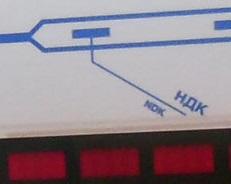
Figure 3: Line panel indicating NDK (National Palace of Culture) subway station inside the train
Figure 4: NDK (National Palace of Culture) on Sofia's subway map
Seeing National Palace of Culture one time (the abbreviation could be NPC or NPoC) and NDK another time, could be confusing for tourists who travel with the subway. The translation of the name of the station should follow the same language policy and translation traditions in all instances. In comparison, the name of the Inter Expo Center station and its abbreviation IEC are correct. That makes us wonder why one of the most touristic places in Bulgaria’s capital is sometimes not translated properly.
The National Palace of Culture is one of the most visited places in Sofia. The building itself was constructed during the communistic era and a lot of events still take place there. It is quite near to Sofia’s main shopping street – Vitosha Boulevard. Due to that fact, tourists are expected to easily find their way to it. However, as can be seen from the signs above, using different types of translation of the abbreviation (Nacionalen Dvorec na Kulturata) could be confusing for non-local people. Language policy should be consistent, especially when it comes to the construction of public facilities.
Zapaden Park
Figure 5 shows the Zapaden Park station, which could be translated as West Park in English. However, as can be seen the name is written simply in Latin letters, instead of being translated. Indeed, this station from 1998 is one of the oldest on line one of the Sofia subway.
Figure 5: Entry sign of Zapaden Park subway station
The question to be asked here is why some names of the stations are translated correctly into English, but the name of one of the oldest ones, Zapaden Park, is not. This could be confusing for visitors of Sofia who use the subway. The Cyrillic is unreadable to them, but the translation makes their journey even more complicated. Angela Robbers, who I mentioned above, shared her experience when she first came to Bulgaria without any knowledge of the official language. For her, traveling with Sofia's public transport was often chaotic and disorganized. The appropriate translation of Zapadan Park would be 'West Park', which would make it more understandable to foreigners in Sofia.
In 1998, Bulgaria was not yet part of any western organization and perhaps because of that English was not a popular language at all. After 2007 and after a long construction and reconstruction period of the subway, the authorities did not change the lack of an English translation for the name of this station. In fact, inside this station the sign board is also written only in Bulgarian. This sign is supposed to serve two groups in society – Bulgarian speakers and English speakers. However, the script in the Latin alfabet is actually useless, because it is not understandable for the second group.
Metro Sofia
Figure 6 shows a number of correctly translated subway stations on Sofia's subway map. Names such as James Bourchier, Joliot – Curie and Princess Marie Louise are correctly written, as well as the names of important locations such as Central Railway Station, Sofia Airport, IEC (Inter Expo Center), Sofia University, Vasil Levski Stadium and Sofia Business Park.
Additions are added by the author of the paper.
Figure 6: English translations on Sofia's subway map
This makes citizens and tourists wonder why some of the stations' names are translated correctly, while others are left with a transliteration in Latin letters. That could be more or less confusing for those who do not speak Bulgarian. Did Sofia Metropolitan, as the builder of the Sofia subway, want to make the area traveler-friendly, and did they forget some stations in the process? Why would they not have changed the name of a station which exists since 1998, when they opt for 'modernization'?
The map on Metropolitan Sofia aims to give travelers a useful schema of the stations. As can be seen there are correctly translated names of places, as well as personal names. The map is part of the online subway linguistic landscape in which two languages are used. Correctly as well as incorrectly written station names, can be found in one and the same image. The language policy for translating the stations in Sofia obviously does not follow a consistent pattern.
Wanted: consistent language policy
In conclusion, it can be said that the linguistic landscape of the Sofia subway is a bilingual area, with regards to the signs and voice recordings produced by Sofia Metropolitan. The authorities, however, have not paid enough attention to language policy and this has lead to the translations being incorrect or not precise enough on various occasions. One of the most common consequences of these types of mistakes is that foreign travelers can become confused. In the language policy certain norms and laws should be fixed and strictly followed. However, in the Sofia subway this doesn't seem to happen. The bilingual signs, on the other hand, show the desire for creating a more international environment in the city. That is one of the steps that Bulgaria and its cities have to make in order to mark progress and create a multicultural environment in the globalized world of today. Future improvements could be made if the authorities would take serious action and would take into consideration the opinions of specialists in the field of translation. That would lead to more understandable signs, which could reach a larger population of citizens and tourists in Sofia.
